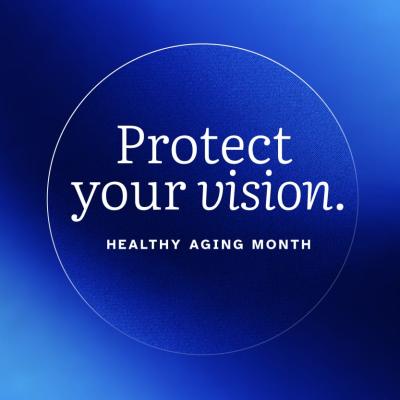What is AMD?
Age-related macular degeneration (AMD) is an eye disease that can blur your central vision. It happens when aging causes damage to the macula — the part of the eye that controls sharp, straight-ahead vision. The macula is part of the retina (the light-sensitive tissue at the back of the eye).
AMD is a common condition — it’s a leading cause of vision loss for older adults. AMD doesn’t cause complete blindness, but losing your central vision can make it harder to see faces, read, drive, or do close-up work like cooking or fixing things around the house.
AMD happens very slowly in some people and faster in others. If you have early AMD, you may not notice vision loss for a long time. That’s why it’s important to get regular eye exams to find out if you have AMD.
What are the types and stages of AMD?
There are 2 types of AMD: dry and wet.
Most people with AMD have dry AMD (also called atrophic AMD). This is when the macula gets thinner with age. Dry AMD happens in 3 stages: early, intermediate, and late. It usually progresses slowly over several years. There’s no treatment for late dry AMD, but you can find ways to make the most of your remaining vision. And if you have late dry AMD in only 1 eye, you can take steps to protect your other eye.
Wet AMD (also called advanced neovascular AMD), is a less common type of late AMD that usually causes faster vision loss. Any stage of dry AMD can turn into wet AMD — but wet AMD is always late stage. It happens when abnormal blood vessels grow in the back of the eye and damage the macula. The good news is that treatment options are available for wet AMD.
What are the symptoms of AMD?
The symptoms of AMD depend on the stage. Dry AMD happens in 3 stages: early, intermediate, and late. AMD is a progressive disease — that means symptoms usually get worse over time.
- Early dry AMD doesn’t cause any symptoms.
- In intermediate dry AMD, some people still have no symptoms. Others may notice mild symptoms, like mild blurriness in their central vision or trouble seeing in low lighting.
- In late AMD (wet or dry type), many people notice that straight lines start to look wavy or crooked. You may also notice a blurry area near the center of your vision. Over time, this blurry area may get bigger or you may see blank spots. Colors may also seem less bright than before, and you may have more trouble seeing in low lighting.
Straight lines looking wavy is a warning sign for late AMD. If you notice this symptom, see your eye doctor right away.
Am I at risk for AMD?
Your risk for AMD increases as you get older. People age 55 and older are more likely to have AMD. The risk for AMD is also higher for people who:
- Have a family history of AMD
- Are Caucasian
- Smoke
If you’re at risk for AMD because of your age, family history, or other factors, it’s important to get regular eye exams. Ask your doctor how often you need to get eye exams. Early AMD doesn’t have any symptoms, so don’t wait for your vision to change!

Healthy Aging Month
Getting older doesn’t have to mean losing your vision. While some vision changes are a normal part of getting older, vision loss related to eye diseases and conditions, such as AMD, can be prevented. Learn how healthy eye habits, like getting a regular dilated eye exam, can help keep your sight strong for years to come.
How can I lower my risk for AMD?
Research shows that you may be able to lower your risk of AMD (or slow vision loss from AMD) by making these healthy choices:
- Quit smoking — or don’t start
- Get regular physical activity
- Maintain healthy blood pressure and cholesterol levels
- Eat healthy foods, including leafy green vegetables and fish

Did you know?
-
AMD is very common — 11 million people in the United States have it
-
Late AMD can happen in 1 or both eyes
-
Having late AMD in 1 eye puts you at higher risk of developing late AMD in your other eye
How will my eye doctor check for AMD?
Eye doctors can check for AMD as part of a comprehensive dilated eye exam. The exam is simple and painless — your doctor will give you some eye drops to dilate (widen) your pupil and then check your eyes for AMD and other eye problems.
Your doctor may also recommend doing a test called optical coherence tomography (OCT). In an OCT test, your eye doctor will take pictures f the inside of your eye with a special machine.
What’s the treatment for AMD?
Treatment for AMD depends on the stage and type. There’s currently no treatment for early AMD, so your eye doctor will probably just keep track of how your eyes are doing with regular eye exams. Eating healthy, getting regular exercise, and quitting smoking can also help.
If you have intermediate AMD in 1 or both eyes, special dietary supplements (vitamins and minerals) may be able to stop it from turning into late AMD. If you have late AMD in only 1 eye, these supplements may slow down AMD in your other eye.
If you have wet AMD, there are other treatments that may be able to stop further vision loss:
- Medicines called anti-VEGF drugs that the doctor injects in your eye
- Photodynamic therapy (PDT), a combination of injections and laser treatment
There’s currently no treatment for late dry AMD — but researchers are hard at work looking for treatment options. And you can get support to help you live with vision loss from AMD.
How do I live with vision loss from AMD?
Not everyone with AMD develops late AMD or gets it in both eyes. But if you do, living with vision loss from AMD can be challenging. Having low vision means that even with glasses, contact lenses, medicine, or surgery, your vision loss makes it hard to do everyday tasks.
The good news is, there are things that can help — like low vision devices and vision rehab services. Vision rehab can help you learn the skills you need to stay independent and active with low vision.

Featured Resource: Talk with Your Doctor About Age-Related Macular Degeneration
Do you have AMD? This guide makes it easy to talk with your doctor about what this means. It includes:
- Information about AMD
- Questions for the doctor
- A symptom tracker
What's the latest research on AMD?
Scientists are studying what causes AMD and how we can treat it better.
One NEI research team found a way to treat dry AMD in animals using stem cells. Researchers are now testing whether this treatment is safe for people. This research could lead to a treatment for dry AMD in the future. Learn how to participate in a clinical trial on stem cells.

